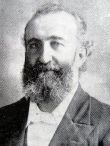Described by its creators as a 'Fairy Tale of Old Japan', and with echoes of The Mikado throughout, the story concerns Djin Djin, an evil demon who holds the talisman that can save the life of Princess Iris. She will die unless someone defeats Djin Djin and liberates the talisman. To do this, they must risk entering the ruined temple where the demon and his horde of followers are based.
The pantomime was advertised as a 'grand spectacular extravaganza,' and indeed it had no fewer than thirty-eight named performers, with a host of other actors and dancers playing roles such as Mousinées, Flower Fairies, Snow Elves, Japanese Ladies, Samurai, Councillors, Officials, Courtiers, Coolies, Guards, Jinrikishamen, Spirits, Demons and Monkeys etc. The principal characters were Prince Omi (a Japanese feudal prince), Prince Eucalyptus (a suitor from the sunny south whose yacht is wrecked on the shores of Japan), Hojo-no-Kami (Diamio, a feudal prince), Princess Iris (a daughter of the Diamio), Cheekee (the Diamio's other daughter), Okiama (the Diamio's maiden sister of uncertain age), Djin Djin (the Bogie-man), Oda Nobunga (the Great Shogun), Prince Omi (the Shogun's son turned into a baboon by Djin Djin), Chrysantheme (the Fairy Queen), Dede, Maid to Princess Iris), Gay-Jay (the Grand Vizier), Fli-qui-Sami (Japan's astrologer), and Tom Wallaby (Prince Eucalyptus' faithful valet and friend).
The scene breakdown for the 1895 Melbourne premiere production was:
Act 1: Scene 1. The Shrine of the Soothsayer;
Scene 2. A Street in Nagasaki;
Scene 3. Palace Gardens of Hojo No Kami. Grand Procession and Fan ballet, Brilliant Illumination of Nagasaki.
Act 2: Scene1 Courtyard of Damio's Palace;
Scene 2. Enchanted Bamboo Grove;
Scene 3. The Frozen Forest. A Novel and Beautiful Transformation. Dance of Snow Elves and Chrysanthemum Ballet;
Scene 4. Exterior of the Haunted Temple;
Scene 5. Interior of the Temple. Grand Demon Trap Scene. The Earthquake. The Eruption of Fuji San.
Act 3: Scene 1. The Shogun's Court; Grand Specialty Entertainment by John Coleman, the Banvards, the Ridgeways, Ivy Scott and Carrie Moore. Off to Fairy Land;
Scene 2. The Golden City; Grand Ballet - Dazzling Scene of Electric Splendour. Grand Harlequinade and old English Comic Scenes by the Ridgeway Family.
[Source: Australian Variety Theatre Archive]


